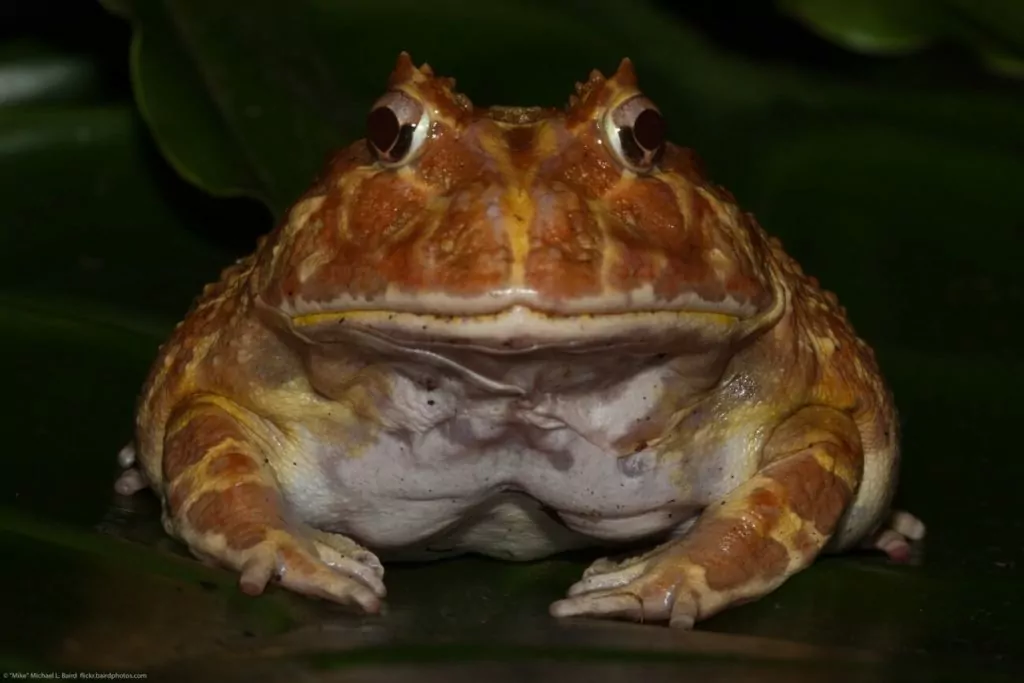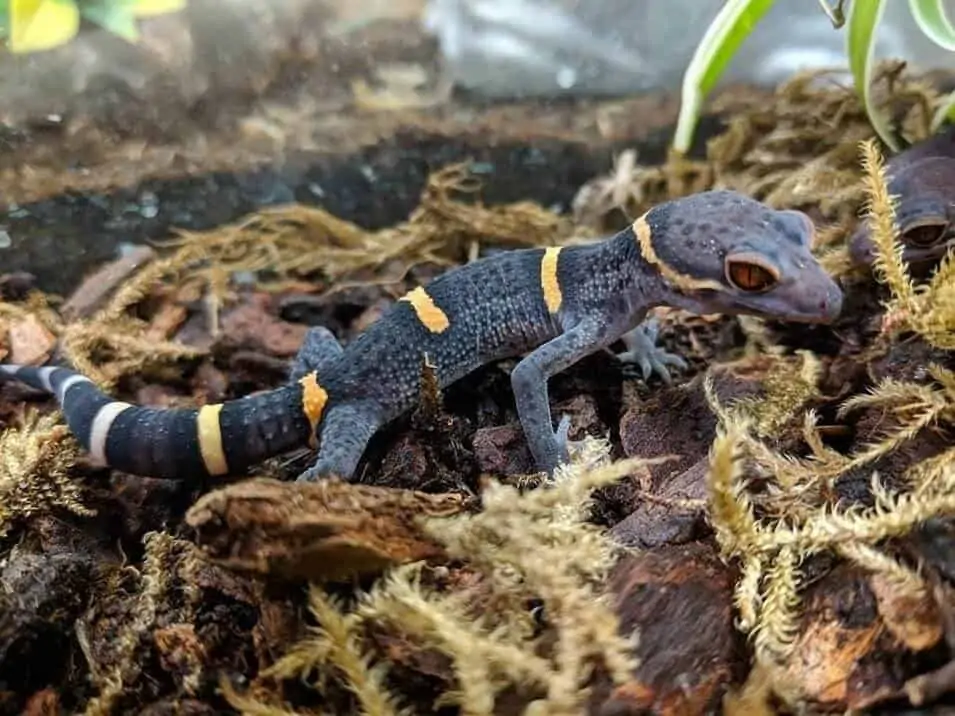Red-eyed tree frogs are one of the most iconic amphibian species in the world. These adorable creatures have captivated our attention for ages, so it’s only natural to want one as a pet!
This guide will teach you everything you need to know about red-eyed tree frog care. You’ll learn about their diet, habitat setup, lifespan, size, and more!
Table of Contents
Species Summary
The red-eyed tree frog (scientific name: Agalychnis callidryas) is one of the most famous frog species in the herpetology scene. Thanks to their bright coloration and relatively easy-going nature, they’re a joy to raise! Accessible and easy to care for, they’re an excellent choice for both seasoned and novice herpetology lovers alike.
Wild red-eyed tree frogs inhabit the canopy layer of rainforests in Central America and northwest parts of South America. They’re prevalent in Mexico, Nicaragua, Costa Rica, Panama, and Colombia. These creatures are true tree-dwellers, adopting an arboreal lifestyle that keeps them up in the trees for most of their life.
In captivity, red-eyed tree frogs need lush habitats that encapsulate all of the best parts of their natural environment. While they have distinct needs to meet, these amphibians are adaptable enough to thrive in well-maintained conditions.
Appearance & Colors
The physical appearance of the red-eyed tree frog is nothing short of spectacular!
As their common name would imply, these critters are sporting vibrant red eyes. The eyes are large and bead-like. They also have a slit pupil that dilates with changing light conditions.
Expert Tip: During the day, you might see the frog’s distinct eyelid shield the red. It doesn’t provide full coverage. Instead, the yellow-colored eyelid features a net-like look that the frog can still see through. The eyelids provide protection and help the high-contrast eyes blend it a bit more while the frog rests.
The rest of the body is just as colorful as the eyes! Most of the frog’s back and legs are bright green. When they tuck the legs under the body and sit on top of leaves, they effortlessly blend into the environment.
However, other eye-catching colors make them stand out during times of high activity.
You’ll notice that the sides of the frog are jewel-toned blue. Some frogs might have distinct yellow stripes that separate the blue color and the green on their backs. The stripes match the net-like detailing of the eyelids!
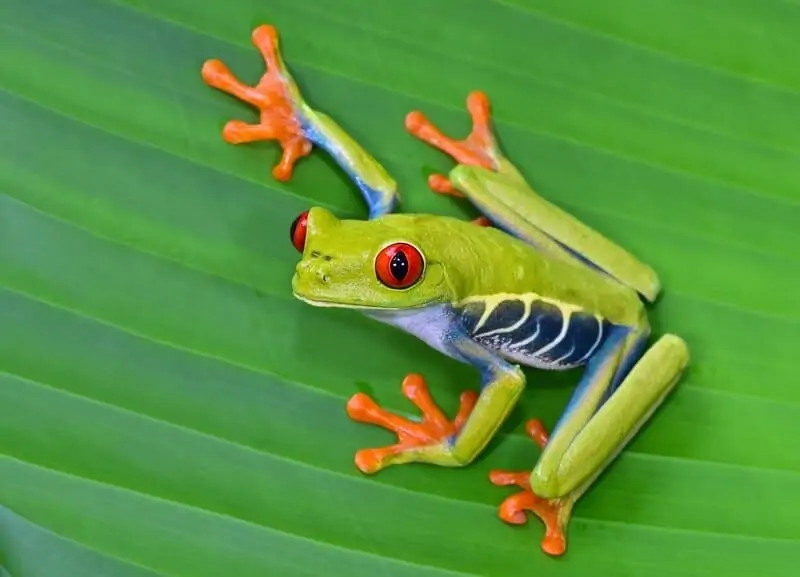
The blue color can appear on the side of the midsection and along the legs. It offers a nice transition to the white underbelly.
Finally, there are the feet!
The red-eyed tree frog has bright orange feet. Like other tree frogs, this species has large feet with round sticky pads. These help the amphibians navigate their surroundings and stick on smooth surfaces.
Expert Tip: Overall, males and females look pretty similar. The main difference between the sexes is size. Females grow up to be bigger and bulkier than males.
If you look closely, you can also identify nuptial pads on the males. They look like brown thumbs on the base of the pads.
Lifespan
There are no guarantees for the red-eyed tree frog or any other pet frog. Many factors can contribute to the frog’s overall lifespan. These include living conditions, genetics, and diet, and more.
With proper care, the typical red-eyed tree frog lifespan is usually between five and ten years.
The level of care you provide can impact the frog’s life expectancy quite a bit. Paying attention to the amphibian’s needs increases the chance that it will live to the upper end of the lifespan spectrum. Meanwhile, substandard care can lead to health complications and early death.
Average Size
Red-eyed tree frogs are pretty small compared to other popular amphibians.
The average red-eyed tree frog size is about three inches for adult females, and two and a half inches for males. In rare instances, you might see females getting a bit bigger.
Red-Eyed Tree Frog Care
Proper red-eyed tree frog care revolves around having a smart approach when it comes to the environmental, dietary, and overall health needs of these creatures. These amphibians live in distinct wild habitats that you must do your best to recreate in captivity.
Creating a habitat with all the essentials can seem like a tall order at first! Fortunately, it’s doable with a bit of knowledge.
Here are some red-eyed tree frog care guidelines you don’t want to miss.
Tank Size
The first thing you need to take care of is finding a tank.
Red-eyed tree frogs do best in glass terrariums or vivariums. Wooden vivariums aren’t a good choice for this species. They can retain too much heat, which might be detrimental to the frog’s health.
Glass, on the other hand, does a fine job of letting heat escape while still maintaining warm conditions. Taller vivariums with mesh tops, controllable ventilation slats, or swing-open doors work best.
So, what about the size?
For a single pair, you can get an enclosure that’s as small as 12 inches long, 12 inches wide, and 18 inches tall.
If you plan on keeping up to four frogs, go for a habitat that’s at least 18 inches long, 18 inches wide, and 24 inches tall. Red-eyed tree frogs are pretty social, so it’s always better to keep them in groups. Never keep a single frog in solitude if possible!
Expert Tip: You’ll notice that the measurements focus on height. Remember, this frog species is arboreal, so they need plenty of vertical height for climbing and decor.
Habitat Setup
One of the most important parts of red-eyed tree frog care is mimicking its natural environment as closely as possible. These amphibians come from lush rainforest jungles, so you have many ways to get creative with the decor here!
You should start by focusing on the substrate. These frogs need an absorbent substrate that holds onto moisture. It helps to raise and maintain humidity levels. More on that later.
You have a couple of different options here. If you want to keep things simple, try using paper towels. They’re easy to replace and don’t come with the risk of accidental ingestion or impaction.
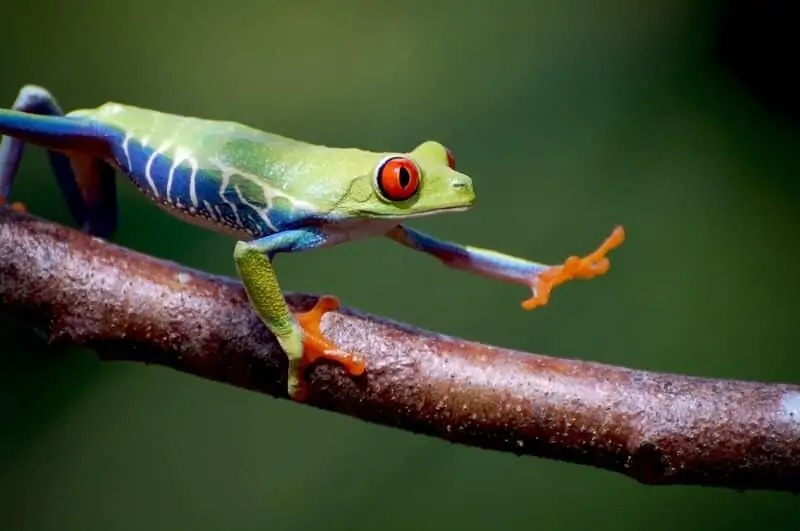
For a more natural look, you can use orchid bark, coconut coir, or sphagnum moss. Whatever you use, apply it to the bottom of the enclosure. Press looser materials down to create a stable surface and reduce the chances of ingestion.
Now, onto the real decorations!
Using a combination of tree branches, logs, and vines, create a network of vertical climbing spaces. Get creative and give your frog plenty of routes to get as high as they want. Try using a mixture of materials to create an organic look.
After that, you can enrich the space with life or fake plants. In the wild, these frogs can be found resting on bromeliad leaves and other plants.
Expert Tip: Live plants are best for humidity, but they will create more of a challenge in the maintenance department. There’s no shame in using plastic and silk plants if you want to keep things simple.
Smaller decorative items can provide more opportunities for enrichment throughout. Use trailing plants to disguise wires and equipment. Rocks and flat logs work well towards the bottom of the enclosure, too.
The sky’s the limit as far as decorations go. Just keep things natural, and your frog should adapt pretty quickly to its new home.
Temperature & Lighting
Red-eyed tree frogs thrive in warm, tropical environments. However, they don’t like areas that are too hot. In the rainforest canopy, they get a nice mixture of shade and sun exposure.
The ideal ambient temperature for this frog species is around 75 degrees Fahrenheit. Nighttime temperatures can drop to the low 70s, but anything lower will put the frog in the danger zone. Use a ceramic heater to ensure that the environment stays warm if you live in a colder climate.
Red-eyed tree frogs need a temperature gradient to thermoregulate. You can create one using a basking lamp or a heat mat. Place the basking lamp above the mesh top of the enclosure and direct it towards an established perch. If you use a heat mat, stick it to one side of the glass.
Use one of these heating tools to raise temperatures between 80 and 85 degrees during the day. The temperature gradient will be subtle, but it’s still required nonetheless.
For lighting, you’ll need standard bulbs on a timer. Red-eyed tree frogs spend most of their day sleeping and relaxing. But come nightfall, they become more active.
Expert Tip: These amphibians are nocturnal, so they require a stable day and night cycle to stay healthy. Keep the lights on for 10 to 12 hours a day before switching them off.
Your frogs can also benefit from UVB lights. Some red-eyed tree frog owners forgo UV lighting altogether, but you can use them to ensure proper health for your frog.
UV light helps the frog synthesize Vitamin D3 and calcium. Without it, they may suffer from debilitating health problems.
To avoid those issues, use a five to six percent UVB tube. Shine it throughout the enclosure during the day to simulate natural sunlight.
Humidity
Providing the right humidity level is one of the most important elements of red-eyed tree frog care.
They’re used to the ultra-humid conditions of a lush rainforest. Anything less in captivity will just spell trouble!
Throughout the day, humidity levels need to stay between 65 and 80 percent. It’s a good idea to invest in a hygrometer so that you can keep an eye on the humidity throughout the day.
Expert Tip: If you want to go the extra mile, use 65 percent as your baseline. Then, allow the humidity levels to spike up to 80 percent in the middle of the day. The rise in moisture simulates the changing conditions in the rainforest.
You can easily achieve that spike by misting the enclosure once per day. Automatic misters are available to help with this as well.
Water
Red-eyed tree frogs get most of their hydration through the moisture in the air. That’s why it’s so important to keep the humidity levels stable.
That said, it’s important to provide a shallow dish of water in their setup as well. The frog might use it to lap up water. They could also take advantage of it to soak and cool off.
Keep the dish relatively small and shallow. It should be big enough for the frog to crawl in but not deep enough to make drowning an issue.
Make sure to provide clean filtered water. Standard tap water often contains chemicals like chlorine or fluoride. While safe for humans, the chemicals are not suitable for frogs.
Use filtered or distilled water when possible.
Expert Tip: Keep an eye on the dish throughout the day and make sure to refill it regularly. You’ll want to clean up any messes that occur as well.
Red-Eyed Tree Frog Food & Diet
Red-eyed tree frogs are insectivores. That means their diet consists of protein-rich bugs only.
In captivity, the best food you can provide is brown crickets! Crickets are readily available, full of nutrition, and tasty enough to appeal to most frogs. Black crickets, roaches, and locusts work, too.
Make sure to provide gut-loaded insects. Gut-loaded insects are fed nutrient-rich foods. Not only does that make the bugs more nutritious, but it ensures that diseases and pathogens aren’t present.
Occasionally, you can also provide mealworms, silkworms, or waxworms. Worms tend to be fattier, so don’t go overboard with the snacks!
Adult red-eyed tree frogs can be fed a few crickets every day. Alternatively, you can offer up larger meals every other day.
Expert Tip: Bigger frogs may fare better with large meals every two to three days.
Whatever schedule you adopt, make sure to dust foods with the appropriate supplements. Red-eyed tree frogs need Vitamin D3 and calcium. Supplement powders are readily available and easy to use. Just dust the insect before mealtime!
Potential Health Issues
These critters aren’t immune to health issues. They suffer from all the usual diseases that captive amphibians experience.
The most significant risks are bacterial infections.
Fortunately, bacterial infections are usually easy to avoid. These infections can plague the skin or cause internal health issues. Frogs get infections from pathogens in the environment.
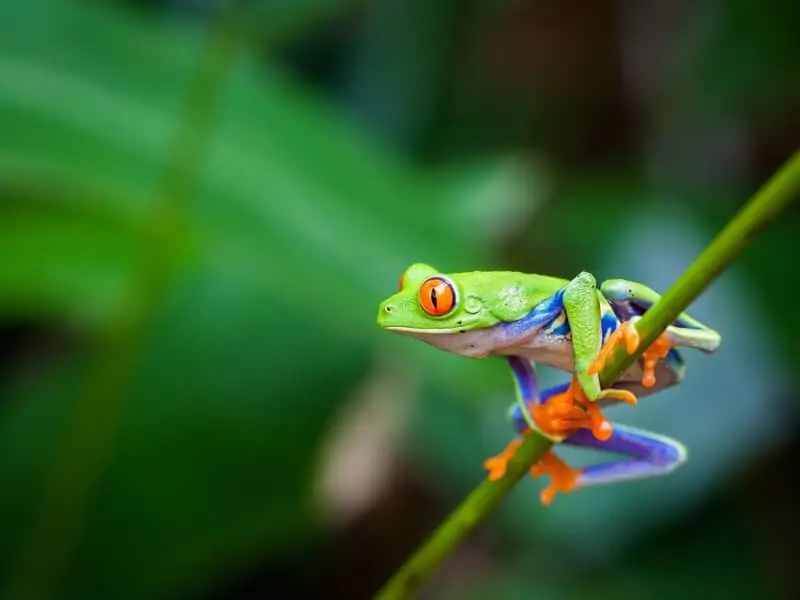
Your frog’s enclosure is the perfect breeding ground for bacteria! It’s warm, humid, and primed for bacterial proliferation.
While you can’t keep the enclosure bacteria-free, you can do your part to keep disease-causing pathogens under control. Spot clean messes as soon as possible. Then, perform a deep clean about once a month.
During that cleaning session, use amphibian-friendly sanitizing products to keep bacteria at bay.
Another big health problem you should be wary of is metabolic bone disease. This condition plagues amphibians that don’t get enough exposure to UV light. They use sunlight to synthesize calcium and Vitamin D3, which supports the bones.
Without it, the skeletal system becomes frail and malformed. Your frog might suffer from regular fractures, deformities, and a host of other issues.
Use UV lighting and food supplements to avoid this condition and keep your frog healthy.
Handling Them
Red-eyed tree frogs are delicate creatures. They can climb onto your hand and wrap themselves around your fingers, but it’s usually a good idea to keep handling to a minimum.
These frogs are best enjoyed through the glass.
You can handle them gently whenever necessary, but try to limit those instances to times of enclosure maintenance. Keep the handling session short and quickly move them to another container.
A more hands-off approach will keep the frog stress-free while also minimizing the chances of injury.
Breeding
Red-eyed tree frogs have a fascinating reproductive process. It’s pretty complex, but you can recreate the appropriate conditions with the right gear.
You’ll need a large rain chamber with several inches of depth at the bottom. The goal is to recreate the rainy season to trigger spawning.
In the wild, these frogs lay eggs onto low-hanging leaves that hove above ponds and rivers. When the eggs hatch, the young tadpoles can fall several meters to the water below.
You don’t need that much space in your rain chamber for red-eyed tree frog breeding, but you’ll need to recreate that scenario. Fill the chamber with large-leaf plants and make sure there are at least three inches of water depth so that the tadpoles have a safe fall.
Move several frogs into the chamber. For the best results, provide two males for a single female. Spawning is more likely to occur if there’s some competition.
To trigger spawning, you’ll need to go through the seasons quickly. Begin by simulating the winter months. This will take a month or two.
Lower the temperature by five degrees and keep the humidity levels to 65 percent. You can also reduce the amount of daylight your frogs get by about two hours.
After maintaining those winter conditions for one or two months, you can move onto the rainy season. Start the rain system and use an internal tank heater to keep the water temperature at about 80 degrees. The ambient air temperatures should rise back to normal.
Breeding should occur within a week. The female will lay her transparent eggs onto overhanging leaves above the water. Once this happens, you can move the adults back to their regular enclosure.
Eggs hatch in about a week as well. The tadpoles will fall into the water and remain motionless for a few days. Once they start moving, begin feeding them and performing partial water changes.
Provide small fish flakes or tadpole food. Blanched lettuce works, too.
Expert Tip: After they develop legs and their tails disappear, you can move them to a high-humidity tank with plenty of water dishes. There, you can provide pinhead crickets and ease their transition to adulthood. In a few weeks, they’ll be ready for a standard red-eyed tree frog enclosure!
Conclusion
As long as you’re willing to provide the right habitat setup and give these amphibians the attention they deserve, red-eyed tree frog care shouldn’t be too difficult. And once you get used to it, you’ll have the joy of owning one of the most famous frogs on the planet!
We hope you found this care sheet helpful and feel ready to take the next step. If you have any lingering questions, feel free to ask us!

